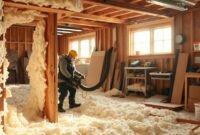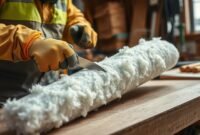Do you have a pole barn that’s freezing in winter and sweltering in summer? Many people struggle with high energy bills because of poor insulation. Drafty barns can cost a lot to heat and cool, making your space uncomfortable and inefficient.
I’m here to show you how to insulate your pole barn on a budget. Affordable insulation can save you a lot of money on energy. Follow my guide to learn how to make your space cozy without spending too much.

Understanding Pole Barn Insulation Basics
Exploring insulation for pole barns showed me how complex it is. It’s not just about keeping it warm or cool. It’s about making a space that’s efficient, comfortable, and protects your investment.
Pole barn insulation has many materials, each with its own benefits. Let’s look at the most common ones:
- Fiberglass: The most budget-friendly blanket insulation for pole barns
- Spray foam: Provides excellent air sealing and high R-value
- Reflective insulation: Great for managing radiant heat
Diving into Insulation Materials
Choosing the right insulation material is key to your pole barn’s energy efficiency. Fiberglass is popular because it’s affordable and works well. Think about your space and climate when insulating a pole barn.
Decoding R-Values
R-values show how well insulation blocks heat. Higher R-values mean better insulation. For pole barns, aim for R-values between R-13 and R-25, based on your local climate.
Read also: Best Insulation for Pole Barn Ceiling
The Critical Role of Vapor Barriers
Vapor barriers fight moisture damage. They stop condensation, which can cause mold, wood rot, and structural problems. Always use a vapor barrier with blanket insulation for pole barns to protect your investment.
Benefits of Proper Pole Barn Insulation
Investing in pole barn energy efficiency is smart and essential. It protects your space and saves money. Proper insulation turns your pole barn into a comfortable, cost-effective place.
Insulation brings many benefits that make it a worthwhile investment:
- Dramatic energy cost reduction
- Temperature regulation in extreme weather
- Protection against moisture damage
- Extended equipment and material lifespan
Energy efficiency starts with a thermal barrier. This barrier keeps your pole barn comfortable all year. In summer, it stops heat from getting in. In winter, it keeps warmth inside.
This means you spend less on heating and cooling. Over time, you can save a lot of money.
Moisture control is another big plus of insulation. It stops condensation, protecting your barn’s structure. This prevents mold or rust, saving you from expensive repairs later.
For farmers, workshop owners, and agricultural professionals, insulation is key. It creates a stable environment for sensitive equipment, livestock, or stored materials. The cost of insulation is repaid through lower utility bills and less damage.
The Cheapest Way to Insulate a Pole Barn
Finding the most affordable way to insulate a pole barn needs careful planning. I’ll show you the best ways to insulate a metal building without spending too much.
Read also: Cheapest Way to Insulate a Metal Building
Cost Comparison of Different Insulation Materials
When looking for the cheapest insulation, knowing material costs is key. Here are the most budget-friendly options:
- Fiberglass insulation: Most economical choice
- Reflective bubble wrap: Low-cost alternative
- Recycled denim insulation: Eco-friendly option
| Insulation Type | Cost per Square Foot | R-Value |
|---|---|---|
| Fiberglass Batts | $0.30 – $0.50 | R-13 to R-21 |
| Reflective Bubble Wrap | $0.20 – $0.40 | R-3 to R-7 |
| Recycled Denim | $0.50 – $0.75 | R-13 to R-19 |
Labor Costs vs DIY Installation
Professional installation can make your costs go up. Doing it yourself can save up to 50% on labor. Think about your skills and time before starting the project.
Long-term Savings Considerations
While finding the cheapest insulation is key, don’t forget about long-term savings. Quality insulation can save a lot on energy costs over time. A better material might save you 30% or more on heating and cooling.
- Calculate possible energy savings
- Think about insulation durability
- Include maintenance costs
It’s important to balance initial costs with long-term savings. With careful planning and the right materials, you can get affordable and effective insulation for your pole barn.
Fiberglass Insulation: The Budget-Friendly Option

Fiberglass is a top pick for pole barn insulation because it’s affordable. I’ve tried many insulation types, and fiberglass is the cheapest without losing quality.
There are two main types of fiberglass insulation for pole barns: batts and rolls. These options offer great heat protection while saving money. Here’s why fiberglass is a wise choice:
- It’s the cheapest per square foot compared to other materials
- Easy to cut and install for DIY fans
- Acts as a good thermal barrier with high R-values
- Available at most home improvement stores
Choosing the right fiberglass insulation depends on your pole barn’s needs. Pick materials with the right R-values for your area and building type.
| Fiberglass Type | Average Cost | R-Value Range | Best Used For |
|---|---|---|---|
| Batts | $0.30-$0.50/sq ft | R-11 to R-21 | Standard wall cavities |
| Rolls | $0.25-$0.45/sq ft | R-13 to R-30 | Larger surface areas |
When installing fiberglass insulation, wear protective gear and ensure full coverage. This way, you can make your pole barn cozy without spending too much.
Installing Insulation Above vs Below Trusses
When you’re doing diy pole barn insulation, where you put the insulation matters a lot. It affects how easy it is to build and how well it keeps energy in.
I’ll explain the two main ways to insulate a pole barn: above the trusses and below them. We’ll look at foam board and other materials.
Pros of Above-Truss Insulation
- Easier installation during initial construction
- Better protection of structural elements
- Minimizes thermal bridging
- Potentially smoother interior finish
Cons of Above-Truss Insulation
- Reduces interior height/storage space
- More expensive initial investment
- Requires precise measurement
Cost Comparison
| Installation Method | Material Cost | Labor Complexity | Energy Efficiency |
|---|---|---|---|
| Above Trusses | $3-$5 per sq ft | Moderate | High |
| Below Trusses | $2-$4 per sq ft | Low-Moderate | Medium |
If you’re working on an existing pole barn, below-truss might be better. It’s often cheaper and less messy. Think about your barn’s layout and what you want from insulation before deciding.
Vapor Barrier Requirements and Solutions
Understanding vapor barriers is key for protecting your pole barn from moisture damage. A good vapor barrier can save you a lot of money on repairs and upkeep.
Vapor barriers are vital for keeping moisture out of your farm building. They stop moisture from getting into your insulation and building materials. This can cause mold, wood rot, and make your insulation less effective.
- Plastic sheeting (6-mil polyethylene) is the most affordable option
- Foil-faced insulation can double as a vapor barrier
- Specialized moisture-resistant membranes for advanced protection
Choose a vapor barrier that fits your climate and building needs. For most pole barns, a simple polyethylene sheet is enough.
| Vapor Barrier Type | Cost | Effectiveness |
|---|---|---|
| 6-mil Polyethylene | $0.50-$1 per sq ft | Good |
| Foil-Faced Insulation | $1-$2 per sq ft | Excellent |
| Specialized Membrane | $2-$4 per sq ft | Superior |
Installing a vapor barrier is easy: just overlap sheets by 6 inches, seal seams with tape, and make sure it covers everything. A good vapor barrier will keep your pole barn strong and well-insulated.
Understanding Wholesale Insulation Pricing
To save on budget pole barn insulation, buying smart is key. Getting affordable metal building insulation directly from the makers can cut costs a lot. I’ve found some tips to help you save more and get the most value for your insulation project.
Buying insulation in big quantities has big benefits for those watching their budget. Cutting out middlemen means you get lower prices and better deals for your project.
Direct Manufacturer Access Benefits
- Significantly lower per-unit pricing
- Access to bulk discount rates
- Direct communication with product experts
- Potential customization options
Bulk Purchase Strategies
Here’s how to get the best wholesale prices for budget pole barn insulation:
- Look for different manufacturers that offer affordable metal building insulation.
- Ask for detailed quotes for big orders.
- Compare prices from different suppliers.
- Try to negotiate for the lowest minimum purchase amounts.
- Think about how you’ll store extra materials.
Pro tip: Some makers give big discounts for orders over 500 square feet. Plan well and know exactly how much insulation you need. This way, you could save 20-30% compared to buying at retail prices.
DIY Installation Tips for Cost Savings

Doing your own pole barn insulation can save a lot of money if you do it right. I’ll give you some useful tips to help you finish your inexpensive pole barn winterizing project without spending too much.
Before you start your insulation project, make sure you have these important tools:
- Measuring tape
- Utility knife
- Protective gloves
- Safety glasses
- Ladder
- Vapor barrier material
Measuring accurately is key for diy pole barn insulation. Always double-check your measurements before cutting. This way, you’ll avoid waste and ensure you cover everything properly. When cutting insulation, use a sharp utility knife on a stable surface for clean cuts.
Your safety should always come first when doing inexpensive pole barn winterizing. Wear long-sleeved clothes, gloves, and safety glasses to protect yourself from irritation and debris.
Here are some pro tips for a successful installation:
- Make sure there’s good ventilation during installation
- Check for any moisture issues before insulating
- Seal all gaps and air leak points
- Use a consistent compression technique for even insulation
By following these tips, you can do your diy pole barn insulation project well and save money. Remember, being patient and careful is important to get professional-quality results.
Common Mistakes to Avoid When Insulating
Weatherproofing your farm building on a budget needs careful planning. Many owners make mistakes that hurt their barn’s insulation and performance.
Working with affordable insulation materials can lead to pitfalls. Knowing these mistakes can save you money and trouble later.
Material Selection Errors
- Choosing insulation based only on price
- Not considering the R-value for your climate
- Picking materials that don’t fit your barn
- Forgetting about moisture resistance
Critical Installation Mistakes
- Leaving gaps in insulation
- Installing vapor barriers wrong
- Ignoring air sealing around edges
- Not dealing with condensation points
Insulating your barn well is more than just saving money. Spend time researching and preparing. This way, your weatherproofing will last and save energy.
Avoiding these mistakes will protect your investment. It will also make your barn more comfortable and useful.
Seasonal Considerations for Insulation Installation
Choosing the right time for your pole barn insulation is important. The season you pick can affect costs and how well it works. I’ll share some tips to help you save money and keep your barn warm.
Installing insulation in winter is tough. The cold can make some materials hard to use and less effective. Fiberglass and spray foam need certain temperatures to work best.
- Spring: Moderate temperatures make installation easier
- Summer: Typically best for most insulation materials
- Fall: Ideal for preparing barn for winter months
- Winter: Most challenging season for installation
I suggest doing your insulation in late summer or early fall. This way, you can get your barn ready for winter. You’ll also avoid the cold and possibly save on materials.
| Season | Installation Difficulty | Cost Considerations |
|---|---|---|
| Spring | Moderate | Mid-range prices |
| Summer | Easiest | Potential bulk purchase discounts |
| Fall | Ideal | Competitive pricing |
| Winter | Most Challenging | Potentially higher labor costs |
Getting ready is essential for a successful insulation job. Look at the weather, make sure your area is clean and dry. Also, buy your materials early to save money.
Read also: Cheap Way to Insulate Block Walls in Your Home
Enhancing Energy Efficiency on a Budget
Improving your pole barn’s energy efficiency doesn’t have to cost a lot. I’ve found ways to cut down on energy use without spending too much. The trick is to use smart insulation and affordable upgrades together.
Here are some easy ways to make your pole barn more energy-efficient without spending a lot:
- Install weatherstripping around doors and windows
- Use LED lighting to reduce electrical consumption
- Create strategic ventilation systems
- Seal possible air leaks with affordable caulking
Using cost-effective insulation materials can really help. I suggest focusing on these areas:
| Improvement Area | Estimated Cost | Energy Savings |
|---|---|---|
| Weatherstripping | $50-$100 | 10-15% heating/cooling savings |
| LED Lighting Upgrade | $100-$250 | Up to 75% electrical reduction |
| Draft Sealing | $30-$75 | 5-10% energy cost reduction |
If you like DIY projects, you can save even more. Simple steps like using foam gaskets, applying window film, and improving air flow can greatly improve your barn’s energy use. You won’t need to spend a lot to do this.
Remember, every little change helps. By using these budget-friendly tips, you’ll make your pole barn more energy-efficient. This will help keep your costs down while keeping your barn comfortable and functional.
Conclusion
Finding the cheapest way to insulate a pole barn doesn’t mean you have to sacrifice quality. We’ve found ways to save money without losing effectiveness. These methods help you keep your barn warm or cool without breaking the bank.
It’s important to think about more than just the upfront cost. Look at how much energy you’ll save, how long it will last, and how easy it is to install. Using materials like fiberglass, foam board, and placing them wisely can cut down costs. This keeps your barn at the right temperature and comfortable.
DIY installation and choosing the right materials are key to saving money. With careful planning and avoiding mistakes, you can make your pole barn energy-efficient. This way, you won’t spend too much money. Remember, good insulation saves you money on heating and cooling in the long run.
Now that you know more about insulating a pole barn, you can make better choices. Whether it’s for farm equipment, a workshop, or storage, these tips will help you do it affordably and effectively.


